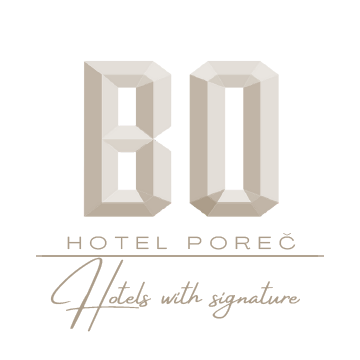

Poreč/Parenzo is a town and municipality on the western coast of the Istrian peninsula, in Istria County, Croatia. Its major landmark is the 6th-century Euphrasian Basilica, which in 1997 was designated a UNESCO World Heritage Site.
The town of Poreč/Parenzo is almost 2,000 years old, and is set around a harbour protected from the sea by the small island of Sveti Nikola/San Nicola (Saint Nicholas). The town's population of approximately 12,000 resides mostly on the outskirts, while the wider Poreč/Parenzo area has a population of approximately 17,000 inhabitants. The municipal area covers 142 square kilometres, with the 37 kilometres long shoreline stretching from the Mirna River near Novigrad/Cittanova to Funtana and Vrsar/Orsera in the south.
Ever since the 1970s, the coast of Poreč/Parenzo and neighboring Rovinj has been the most visited tourist destination in Croatia.

Meet the mystical world of nature which has been developing for thousand of years, far away from the light of the day and the human eye. Visit the underworld the Baredine Cave.
This cave is a treasure chest of stalagmites and stalactites, underworld sculptures created through time by the patient work of water. Such shapes have been created, some of which are exceptional, such as the 10 meter long and high curtains, a very realistic sculpture of Our Lady, the body of a milkmaid called Milka, the leaning tower of Pisa and snowman the torchbearer-who has become the trade mark of our cave.
In one of the atriums you will pass a crater that is 4m wide and 66 m deep which goes down to the underground lakes. And so through five halls, five galleries of abstract and realistic sculptures, a pleasant 40 minute walk, accompanied by our guide and custodian. The excitement of this adventure is also meeting the animals of the underworld. You will see the human fish an endemic animal that lives only in this environment.
At the cave's entrance there is a museum showcase where pottery of prehistoric man has been exhibited. Our far ancestors would probably leave the pots during the hot, dry, summer day to collect the precious water, drop by drop. Cave Baredine is situated near the place Nova Vas, in the vicinity of the towns Poreč, Višnjan and Tar-Torre. The road that leads to the cave is marked with signs, and next to the cave is a spacious parking lot for cars and buses.
The depth of the cave is 132 meters with underground lakes whose depth sometimes reaches 30 meters. Temperature in the cave is non-varying and lies at 14ºC.

The Poreč cathedral is one of the most important cultural and historical monuments in Croatia, and its importance at the global scene has also been recognised by UNESCO, when it was included on the world heritage list in 1997.
The cathedral area is located at the northern side of the Poreč peninsula and includes, apart from the church, the bishop’s palace, the font, valuable archaeological remains of older churches and mosaics, 3rd c. painting techniques.
With its grandiose dimensions, this three-nave cathedral was built on the foundations of the 5th and 6th c. Early Christian churches, which is evidenced by the famous floor mosaics.
The basilica was built following the order of the bishop Euphrasius of Poreč in the 6th c, and it was named after him. There is no much historical evidence about bishop Euphrasius himself. It is know that he originated from Thrace and became a bishop in Poreč when the byzantine emperor Justinian conquered Istria. Euphrasius dedicated the basilica to St Mary’s Assumption and St. Maurus, the patron saint of the city. Its apse was decorated by one of the most beautiful preserved early Byzantine mosaics on Mediterranean which, among others, show him with the basilica in his hand.
The complex of the Euphrasian basilica has, due to its architectural complexity and gradual emergence through different historical periods to the present times, remained the inexhaustible source of historical findings, as well as the challenge to the researches and art historians from different parts of the world.

The sculpture park of world renown artist Dušan Džamonja (1928 – 2009) is situated close to Vrsar.
His monumental abstract sculptures are placed in the natural environment surrounding his house and studio. In his works, Džamonja experiments by using traditional materials in a new way. He combines glass, metal and wood, fills wired meshes with black pressed concrete, experiments with bronze, alluminium, corteen steel. A sculpture technique in which iron nails are being pressed and the wooden structure burnt to leave only the metallic shell exposed. This method give to Džamonja's sculptures a new value of inner space and light.
A visit to this unique park, in which part of Džamonja's work is being kept, is a special experience that will be appreciated by contemporary art conossieurs ad by everyone wishing to spend some time enjoying modern sculpture and relaxing in the peaceful and green environment of the park.

Poreč historical festival – Giostra gathers over 250 participants in costumes who, throughout the 3 festival days, evoke for the spectators life in the Baroque period thus making it a unique festival in Croatia.
This cultural, educational and tourist manifestation stems from historical facts, so most of its events are connected to the 18th century. The central festival event, which also gave Giostra its name, is a knight tournament Giostra, reconstructed from the rules of a tournament held in Poreč in the year 1745.
You will be greeted by:
- Gorgeous ladies and handsome gentlemen in baroque costumes
- Baroque music
- Knight tournament
- Historical knights’ camp (military encampment)
- Local produce and old trades
- Theatrical performances
- Drummers
- Flag jugglers
- Swordsmen
- Street entertainers

Marafore square was a central square in ancient times, the forum, with important public and administrative buildings and temples. Today it looks rather shabby while awaiting its renovation. Just a few dozen centimeters below the current platform is a well preserved original ancient pavement.
Some of the buildings located on the square have regained their public function – primarily the Town Library which interior holds a fragment of the original ancient pavement, also visible inside the Children's Library. Ground floor areas of several buildings have become bars and restaurants, while a portion of the original Marafor pavement and the foundations of its buildings are visible on the north-west side of the Square.

The widespread reputation of the leading exhibition of the wine and other autochthonous agrarian Istrian products such as grappa, olive oil, honey, cheese and prosciutto, confirms the gastronomic importance of these products. Three days of exhibition are fulfilled with various happenings because Vinistra is not just the local products exhibition, but an event implying professional wine tastings, presentations and topic meetings as well.
Apart from Istrian winemakers, there are also Slovenian, Italian and Hungarian colleagues who take part in the competitions. The judge panel, chosen as in other similar world events, consists both of professionals as well as people who simply like and enjoy wine and who find it very precious for their work.
The main purpose of the exhibition is the wine quality testing while other different off-programs make Vinistra even more interesting. This high-quality event unites a record number of wine exhibitors in one place for a few days and makes possible the education and further development of the wine regarding knowledge. Vinistra became the major exhibition of that kind in Croatia and its ever growing significance confirms the number of the exhibitors coming from the whole country of Croatia as well as from abroad.


